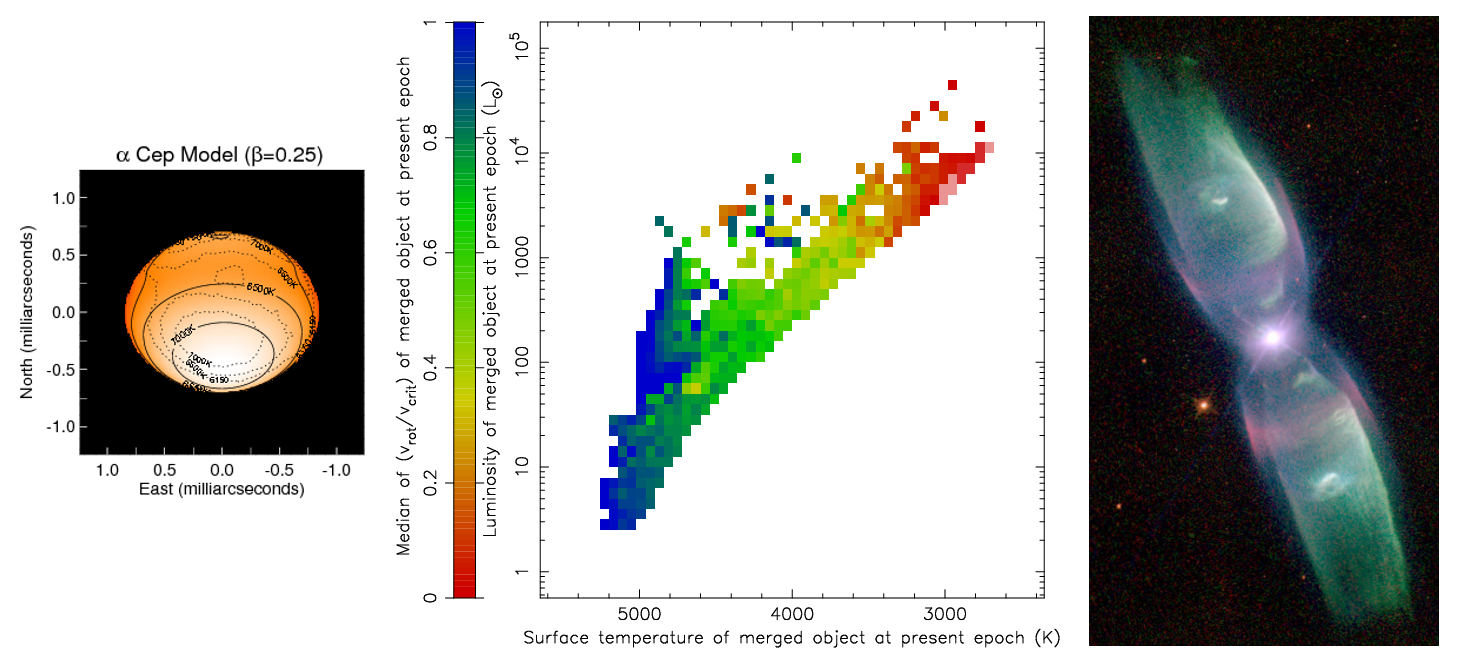Daily Image
11-05-2010Today's colloquium: Population synthesis of common-envelope mergers on the giant branches (M. v. d. Sluys, University of Alberta)
| Submitter: | Jean-Mathias Griessmeier |
| Description: | We developed a population-synthesis code to study in detail populations of binary systems that initiate a common-envelope phase while the primary star is on either the red-giant branch or the asymptotic giant branch, and where the secondary is a main-sequence star or a brown dwarf. As input for our code, we use a grid of detailed stellar-evolution models. If the spiral-in of the orbit during the common-envelope phase leads to the merger of the binary, we use a crude method to determine a model for the merger remnant and follow its subsequent evolution, including mass- and angular-momentum loss due to rapid rotation, to the present epoch. We compute present-day observable properties for our merger population, such as the relative numbers of merger products, their rotational velocities and oblatenesses, and the amount of circumstellar material, and compare these to single-star populations and to observations. We find that the rotational velocities in our merger population, although strongly dependent on our assumptions for enhanced mass loss, are about an order of magnitude higher than that of a population of normal single stars, and that stars on the red-giant branch are underrepresented compared to stars on the horizontal branch and asymptotic giant branch. We have a natural explanation for single sdB stars and we can possibly explain observed composition anomalies. Image above: When the primary star in a binary fills its Roche lobe while on the giant branch, a common envelope (CE) can occur. A CE is believed to strongly reduce the orbital separation, and in about 50% of the cases this will result in the merger of the two binary components. The middle panel of this figure shows a theoretical distribution of present-day observable merger products thus formed, on an Hertzsprung-Russel diagram. The colours represent the median rotational velocity of the stars in each pixel, as a fraction of the "critical velocity" (which is defined as a third of the Keplerian break-up velocity here). Many merger remnants are observed on the lower red-giant branch (RGB) and can be found in the lower-left corner of the distribution, because evolution is slower there than higher up the RGB. As the figure shows, rotational velocities are lower at the upper RGB, because of the expansion of the stars during their evolution. The blue region around 100 solar luminosities represents the horizontal branch (HB), where stars spend a relatively long time burning helium in their cores. When helium ignites in the core, a giant star shrinks significantly, giving rise to the large rotational velocities on the HB. Rotationally enhanced winds may lead to the loss of most of the stellar envelope and may give rise to blue HB stars or sub-dwarf B stars. We expect that the fastest rotators in our population will have shapes that measurably deviate from spherical and estimate that oblatenesses may be as large as 0.5, comparable to that measured for alpha Cephei (left panel, Zhao et al., 2009). While rotational velocities are not as high on the upper asymptotic giant branch (AGB, upper-right part of the distribution in the middle panel), the rotation of these stars is about an order of magnitude faster than for normal single stars and may well contribute to the geometry of the strong stellar winds that are experienced in this evolutionary phase, thus giving rise to the typical bipolar shape of many planetary nebulae, such as M2-9 (right panel, HST, 2007). |
| Copyright: | Zhao et al., 2009 (The Astrophysical Journal, 701:209–224, 2009, August 10), (c) 2009 The American Astronomical Society; M. v. d. Sluys; B. Balick (University of Washington) and NASA |
| Tweet |  |
